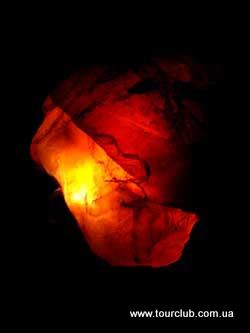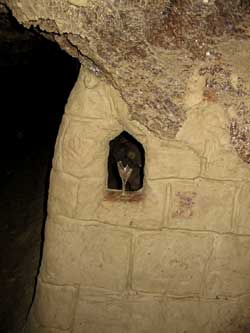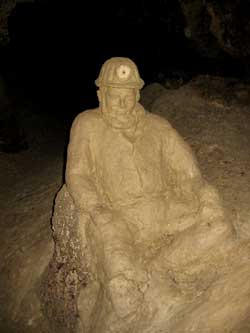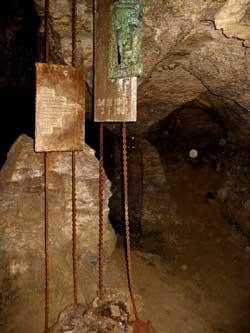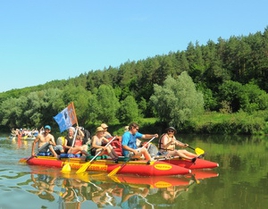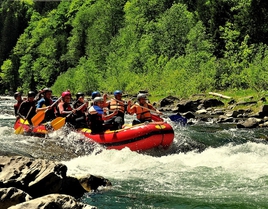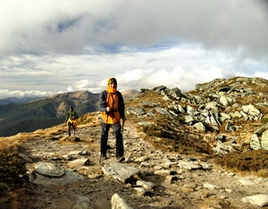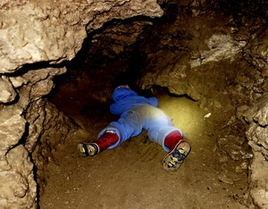Optymistychna (Optimistic) Cave
Optymistychna cave on Transdniester Podillya was discovered by a group of Lviv speleologists led by M. Savchyn in 1966. The story of this discovery is the following.
An intensive development of speleological movement begins in early 60’s in Ukraine. Speleologists of different towns began to explore the known and accessible caves, search the lost during World War II entrances and re-discover the caves, mentions of which remained in the literature. Such well-known giants-labyrinths as Kryshtaleva, Ozerna (Popova yama – Priest’s pit), Verteba caves and others were re-discovered and explored. At the same time a search for new unknown caves was being carried out. In April 1965, a group of Lviv speleologists came across the traces of a big unknown cavity. A small stream that disappeared underground at the bottom of a karst crater in the forest near the village of Korolivka, led deep into the large gypsum solid mass. Strong air draft from a gap above the stream indicated the presence of volumetric cavities in mountain rocks. Entering the cave was done in a year. After two days of excavation on May 8, 1966 at 14.00 a team led by Myron Savchyn first got into an unknown cave and followed its passageways the first hundred meters. It was called Optymistychna.
|
|
|
| ceiling | CaveArt |
Since then a regular exploration, trailbreaking and mapping of the cave by the expeditions of Lviv speleoclub “Cyclops” began. The general management of the research was done by a club president M. Savchyn. The cave is horizontal, of a labyrinth type, embedded in 20-25-meter thick layer of gypsum at a depth of 60-80 m. It consists of 10 relatively isolated areas, interconnected by one or more passageways.
Some areas laid in different geological units with different history of development and formation, differing in geomorphological features, morphometric characteristics, the direction of dominant fracturing, secondary mineral formation, were discovered in different years. Study of some of them still continues.
The cave is not flooded. There are several small lakes with a relatively constant level. The biggest of them is Aqva vitae with surface area of 82 m2. In addition there are several water sources, subject to regional fluctuations of water level. During its peak, which can last for several years, "Fresh Water" area and the southwest of the Central area are partially subjected to flooding. The entrance part and a blocked cave entrance can be flooded with seasonal floods for a period of several days up to 1-2 weeks.
Since 1968, the labyrinth research has been carried out from underground based camps located in different parts of the cave near various water sources. Since then great attention has been focused on the creation of freight routes in the cave and their constant improvement, in particular, providing underground based camps with fixed telephone lines.
The system of freight tracks and underground based camps provides chances for research and at the same time is an objective cave protection that supports a balance of ecological system "cave-man" during long term trailbreaking.
Since 1967 apart from Ukrainian speleologists, speleologists of many countries of the world: Bulgaria, Poland, Hungary, Slovakia, Germany, France, England, Russia an Byelorussia worked in Lviv expeditions in Optymistychna cave.
In the late 80's there was a change of researchers generations. Cavers of youth club "Motherland" of Lviv Centre of Children and Youth Arts of Halychyna started with simultaneous opening of the cave extension in two directions to the west and east of Anaconda area in January 1988. Inheriting achievements, methods and problems of Optymistychna cave from speleoclub "Cyclops", young cavers continue studies. Expeditions of speleoclub "Batkivshchyna" (Motherland) carried out trailbreaking and mapping of the last 40 km of the labyrinth. Since then the general management of the research is performed by a club instructor, Nelia Ostyanova.
At the time of joint map compiling (January 1997) the total length of all passageways of the cave was 192 km. Therefore Optimistic Cave is the longest cave in Europe, among the longest gypsum caves of the world and the second cave of the world by total length of cave passageways (second only to the cave system of Flint-Mammoth, Kentucky, USA).
|
|
|
| Mr. Zeldin | grotto Overbah |
A new discovery of the great extension of Optymistychna cave (in its southeast-western part) was made during the January (1997) by an expedition of a speleoclub "Motherland". According to two research expeditions (in April and July, 1997) the total length of the cave exceeded 200 km. The extension develops towards a significant and very promising, due to geological features, gypsum solid mass, where, according to our forecasts, labyrinths probably exist, exceeding in total length the old part of Optymistychna cave. Trailbreaking continues.
Information from archives of Ternopil speleoclub
1966 - Lviv cavers dug a cave, known as Optymistychna.
In 1966 three expeditions were made:
- 1 expedition – June – cave length is 1345 m;
- 2 expedition – August – cave length is 6333 m;
- 3 expedition – November – cave length is 8976 m.
1967 – Lviv speleologists continued Optymistychna cave mapping:
- 4 expedition - January - the length of the cave - 9,948 m;
- 5 expedition - May - the length of the cave - 15,678 m;
- 6 expedition - July - the length of the cave - 15,678 m;
- 7 expedition - August - the length of the cave - 18,885 m;
- 8 expedition - November - the length of the cave - 20,342 m.
1968 – that year Lviv speleologists carried out 3 expeditions:
- 9 expedition - May - the length of the cave - 20,662 m;
- 10 expedition - August - the length of the cave - 23,277 m;
- 11 expedition - November - the length of the cave - 30,444 m.
Optymistychna cave came out on top position in length in the USSR.
1969 - following the expedition of Lviv speleological club "Cyclops":
- 12th expedition - May - the length of the cave - 37,132 m;
- 13th Expedition - August - the length of the cave - 43,572 m;
- 14th Expedition - November - the length of the cave - 51,608 m.
|
№ |
Names of areas |
Year Opening |
Discoverers |
The lenght of caves passages, m |
Specific volume, m3 /m |
|
1 |
Old |
1967 |
M. Savchyn |
10.110 |
1.26 |
|
2 |
Globes |
1967 |
Yuri Vasiliev,G.Rybytska |
11.089 |
1.83 |
|
3 |
Central |
1968 |
M. Savchyn, K.Stelmashchuk |
47.918 |
2.32 |
|
4 |
Far |
1971 |
M. Savchyn, G.Rybytska |
27.331 |
2.89 |
|
. |
Subdistrict "January 18" |
1992 |
D.Popov, B.Platoshyn, A.Fleet | - | - |
|
5 |
Lacustrine |
1972 |
V.Ivanov, G.Tkachuk |
20.950 |
3.65 |
|
6 |
Zaozernoe |
1977 |
A.Vovk, A. Medvedev |
31.224 |
3.32 |
|
. |
Subdistrict "Mirage" |
1985 |
I. Malyavskyy |
- |
- |
|
7 |
Wind |
1977 |
A.Medvedev, JHarhalis, L.Sukhov, L.Sukhomlyn |
6.025 |
2.80 |
|
8 |
Anaconda |
1977 |
A.Derev'yahin, V.Ovcherenko |
7.974 |
2.08 |
|
. |
Anaconda-west |
1988 |
A.Dobriansky, I.Turchynov |
- |
- |
|
9 |
Fresh water |
1978 |
A. Medvedev, O.Kovalchuk |
21.014 |
1.93 |
|
10 |
Anaconda-east |
1988 |
A. Medvedev |
8.368 |
2.39 |
speleoclub "Cyklop"
Lviv
speleoclub "Bat'kivshchyna"
august, 1997
